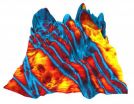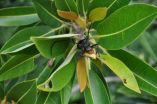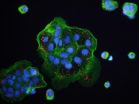(Press-News.org) Using a satellite X-ray telescope combined with terrestrial radio telescopes the pulsar was found to flip on a roughly half-hour timescale between two extreme states; one dominated by X-ray pulses, the other by a highly-organised pattern of radio pulses.
The research was led by Professor Wim Hermsen from The Netherlands Institute for Space Research and the University of Amsterdam and will appear in the journal Science on the 25th January 2013.
Researchers from Jodrell Bank Observatory, as well as institutions around the world, used simultaneous observations with the X-ray satellite XMM-Newton and two radio telescopes; the LOw Frequency Array (LOFAR) in the Netherlands and the Giant Meter Wave Telescope (GMRT) in India to reveal this so far unique behaviour.
Pulsars are small spinning stars that are about the size of a city, around 20 km in diameter. They emit oppositely directed beams of radiation from their magnetic poles. Just like a lighthouse, as the star spins and the beam sweeps repeatedly past the Earth we see a brief flash.
Some pulsars produce radiation across the entire electromagnetic spectrum, including at X-ray and radio wavelengths. Despite being discovered more than 45 years ago the exact mechanism by which pulsars shine is still unknown.
It has been known for some time that some radio-emitting pulsars flip their behaviour between two (or even more) states, changing the pattern and intensity of their radio pulses. The moment of flip is both unpredictable and sudden. It is also known from satellite-borne telescopes that a handful of radio pulsars can also be detected at X-ray frequencies. However, the X-ray signal is so weak that nothing is known of its variability.
To find out if the X-rays could also flip the scientists studied a particular pulsar called PSR B0943+10, one of the first to be discovered. It has radio pulses which change in form and brightness every few hours with some of the changes happening within about a second.
Dr Ben Stappers from The University of Manchester's School of Physics and Astronomy said: "The behaviour of this pulsar is quite startling, it's as if it has two distinct personalities. As PSR B0943+10 is one of the few pulsars also known to emit X-rays, finding out how this higher energy radiation behaves as the radio changes could provide new insight into the nature of the emission process."
Since the source is a weak X-ray emitter, the team used the most sensitive X-ray telescope in existence, the European Space Agency's XMM-Newton on board a spacecraft orbiting the Earth. The observations took place over six separate sessions of about six hours in duration. To identify the exact moment of flip in the pulsar's radio behaviour the X-ray observations were tracked simultaneously with two of the largest radio telescopes in the world, LOFAR and the GMRT.
What the scientists found was that whilst the X-rays did indeed change their behaviour at the same time as the radio emission, as might have been expected, in the state where the radio signal is strong and organised the X-rays were weak, and when the radio emission switched to weak the X-rays got brighter.
Commenting on the study's findings the project leader Wim Hermsen says: "To our surprise we found that when the brightness of the radio emission halved, the X-ray emission brightened by a factor of two! Furthermore the intense X-rays have a very different character from those in the radio-bright state, since they seem to be thermal in origin and to pulse with the neutron star's rotation period."
Dr Stappers says this is an exciting discovery: "As well as brightening in the X-rays we discovered that the X-ray emission also shows pulses, something not seen when the radio emission is bright. This was the opposite of what we had expected. I've likened the changes in the pulsar to a chameleon. Like the animal the star changes in reaction to its environment, such as a change in temperature."
Geoff Wright from the University of Sussex adds: "Our observations strongly suggest that a temporary "hotspot" appears close to the pulsar's magnetic pole which switches on and off with the change of state. But why a pulsar should undergo such dramatic and unpredictable changes is completely unknown."
The next step for the researchers is to look at other objects which have similar behaviour to investigate what happens to the X-ray emission. Later this year there will be another round of simultaneous X-ray and radio observations of a second pulsar. These observations will include the Lovell telescope at Jodrell Bank Observatory.
### END
Chameleon pulsar baffles astronomers
2013-01-25
ELSE PRESS RELEASES FROM THIS DATE:
Genetic landscape of common brain tumors holds key to personalized treatment
2013-01-25
Nearly the entire genetic landscape of the most common form of brain tumor can be explained by abnormalities in just five genes, an international team of researchers led by Yale School of Medicine scientists report online in the Jan. 24 edition of the journal Science. Knowledge of the genomic profile of the tumors and their location in the brain make it possible for the first time to develop personalized medical therapies for meningiomas, which currently are only managed surgically.
Meningioma tumors affect about 170,000 patients in the United States. They are usually ...
New Year brings (potentially) good news for conservation of species on Earth
2013-01-25
Claims that most species will go extinct before they can be discovered have been debunked in the latest issue of Science, by researchers from The University of Auckland, Griffith University, and the University of Oxford.
The scientists show that the claims are based on two key misconceptions: an over-estimation of how many species may exist on Earth, and the erroneous belief that the number of taxonomists (people who describe and identify species) is declining.
"Our findings are potentially good news for the conservation of global biodiversity," says lead author Associate ...
Organic ferroelectric molecule shows promise for memory chips, sensors
2013-01-25
At the heart of computing are tiny crystals that transmit and store digital information's ones and zeroes. Today these are hard and brittle materials. But cheap, flexible, nontoxic organic molecules may play a role in the future of hardware.
A team led by the University of Washington in Seattle and the Southeast University in China discovered a molecule that shows promise as an organic alternative to today's silicon-based semiconductors. The findings, published this week in the journal Science, display properties that make it well suited to a wide range of applications ...
HIV-like viruses in non-human primates have existed much longer than previously thought
2013-01-25
Viruses similar to those that cause AIDS in humans were present in non-human primates in Africa at least 5 million years ago and perhaps up to 12 million years ago, according to study published January 24 in the Open Access journal PLOS Pathogens by scientists at Fred Hutchinson Cancer Research Center. Until now, researchers have hypothesized that such viruses originated much more recently.
HIV-1, the virus responsible for AIDS, infiltrated the human population in the early 20th century following multiple transmissions of a similar chimpanzee virus known as SIVcpz. Previous ...
Bats split on family living
2013-01-25
For the tiny Daubenton's bat, the attractions of family life seem to vary more with altitude than with the allure of the opposite sex.
For more than a decade, a team led by Professor John Altringham from the University of Leeds' School of Biology has studied a population of several hundred bats along a 50-km stretch of the River Wharfe. They monitored roosts in Ilkley and Addingham, upstream in the market town of Grassington and higher still in the villages of Kettlewell and Buckden.
The researchers found that all Daubenton's bats in nursery roosts in lowland areas ...
Extinction rates not as bad as feared ... for now
2013-01-25
Concerns that many animals are becoming extinct, before scientists even have time to identify them, are greatly overstated according Griffith University researcher, Professor Nigel Stork.
Professor Stork has taken part in an international study, the findings of which have been detailed in "Can we name Earth's species before they go extinct?" published in the journal Science.
Deputy Head of the Griffith School of Environment, Professor Stork said a number of misconceptions have fuelled these fears, and there is no evidence that extinction rates are as high as some have ...
Organizing human specimen collections: Getting the best out of biobanks
2013-01-25
The diversity of biobanks, collections of human specimens from a variety of sources, raises questions about the best way to manage and govern them, finds a study published in BioMed Central's open access journal Genome Medicine. The research highlights difficulties in standardizing these collections and how to make these samples available for research.
Biobanks have been around for decades, storing hundreds of millions of human specimens. But there has been a dramatic increase in the number of biobanks in the last ten years, since the human genome sequencing project. ...
Immune cell suicide alarm helps destroy escaping bacteria
2013-01-25
CHAPEL HILL, N.C. – Cells in the immune system called macrophages normally engulf and kill intruding bacteria, holding them inside a membrane-bound bag called a vacuole, where they kill and digest them.
Some bacteria thwart this effort by ripping the bag open and then escaping into the macrophage's nutrient-rich cytosol compartment, where they divide and could eventually go on to invade other cells.
But research from the University of North Carolina School of Medicine shows that macrophages have a suicide alarm system, a signaling pathway to detect this escape into ...
Out-of-pocket costs for breast cancer probably manageable for most Canadian women
2013-01-25
Out-of-pocket costs resulting from breast cancer care in the year following diagnosis are likely manageable for most women, but some women are at a higher risk of experiencing the financial burden that comes from those costs in Canadian breast cancer patients, according to a study published January 24 in the Journal of the National Cancer Institute.
While extensive information about the level of out-of-pocket costs after early breast cancer diagnosis has been unavailable until now, the costs resulting from the disease and the effects the costs have on family financial ...
Fruit and vegetable intake is associated with lower risk of ER- breast cancer
2013-01-25
There is no association between total fruit and vegetable intake and risk of overall breast cancer, but vegetable consumption is associated with a lower risk of estrogen receptor-negative (ER-) breast cancer, according to a study published January 24 in the Journal of the National Cancer Institute.
The intake of fruits and vegetables has been hypothesized to lower breast cancer risk, however the existing evidence is inconclusive. There are many subtypes of breast cancer including ER- and ER positive (ER+) tumors and each may have distinct etiologies. Since ER- tumors, ...


